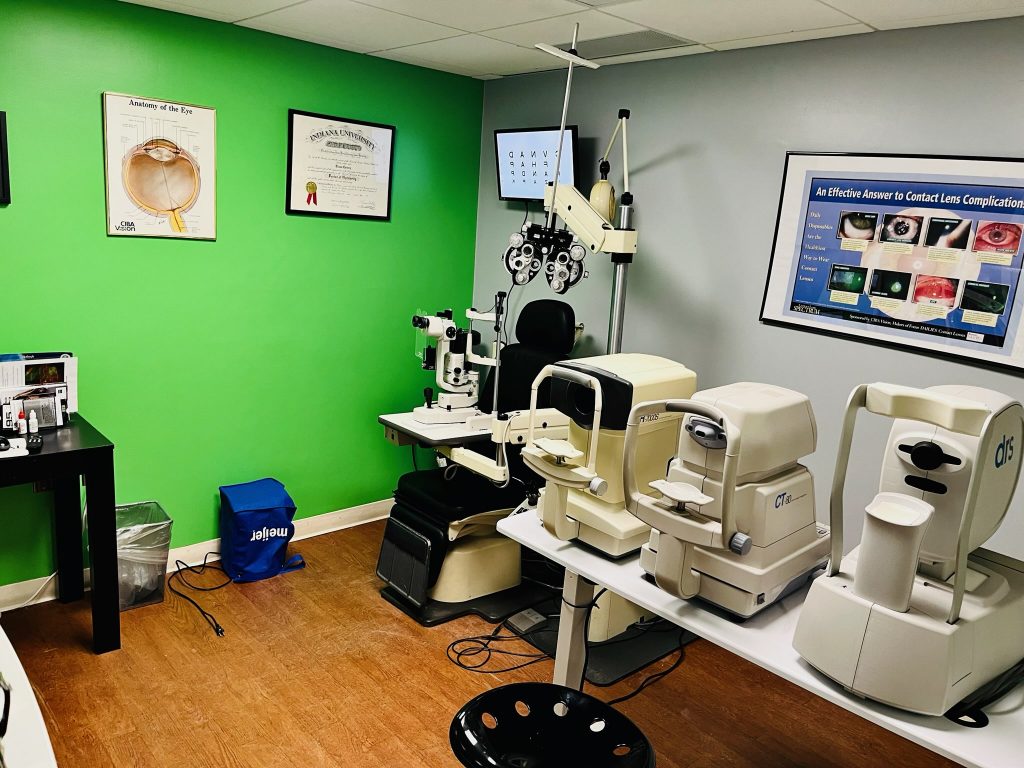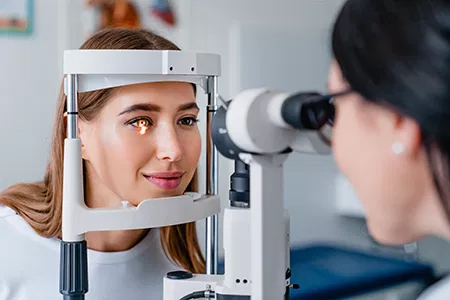Your eyesight is a precious gift, and protecting against vision loss is essential to maintaining your quality of life. By taking the simple step of making a comprehensive eye examination part of your healthcare routine, you can help safeguard your vision.
As part of a comprehensive eye examination, W. Optical will assess your eye health and every aspect of your vision. In addition to determining your proper eyeglass or contact lens prescription, we’ll screen for eye diseases that can lead to vision loss, as well as check for any other problems that may affect eye health. Since your eyes can be an indicator of your overall health, we’ll also look for any warning signs of underlying medical conditions such as high blood pressure, high cholesterol, or diabetes.

It’s also essential for children to have their eyes checked on a regular basis. Periodic eye exams help determine if their vision is developing on schedule and detect any emerging issues that might require treatment.
By scheduling an appointment with the office of W. Optical for routine exams and care, we can help you and every member of the family enjoy optimal vision while protecting the health of their eyes.
The value of comprehensive eye exams
A comprehensive eye exam provides an in-depth look at the health of your eyes and a thorough assessment of the quality of your vision.
We begin by reviewing your overall medical history and gathering relevant information on your eye health history and that of your family. We’ll also discuss any symptoms you may be experiencing, along with any work-related or environmental conditions that may affect your vision. You’ll then receive a thorough clinical examination to check the health of your eyes and assess the quality of your vision. While taking a close look at your eyes, we perform a series of comfortable tests to determine your visual acuity. We also check the degree to which your eyes work together, how well your eyes follow a moving object, your depth perception, and evaluate other indicators of vision function.
You’ll also be carefully screened for the development of eye diseases that can lead to vision loss. Many eye diseases, including glaucoma), macular degeneration, diabetic retinopathy, as well as other conditions affecting the retina, demonstrate few if any overt signs or symptoms until irreparable damage to your eyesight has occurred. Detecting diseases that can threaten your sight in their earliest stages supports effective management and care.
As surprising as it sounds, your eyes are the only part of the body where blood vessels and nerve tissue can be viewed directly without surgery. For this very reason, a comprehensive eye exam can potentially reveal telltale signs of illnesses and medical conditions that have originated elsewhere in the body. Eye exams can provide critical findings in the diagnosis of congenital syndromes & inherited disorders, primary cancers and metastases, cardiovascular disease, circulatory problems, blood disorders, autoimmune diseases, and infectious diseases, endocrine disorders, or the side effects of certain drugs.
At W. Optical, we’re passionate about providing the highest quality of care and dedicated to meeting the vision care needs of every member of your family. We offer a complete range of services, including comprehensive exams, prescription lenses, and contacts, as well as vision screening services to detect any developing conditions affecting the health of your eyes.
What to expect during a comprehensive exam

A comprehensive eye exam involves a series of comfortable and pain-free tests that offer a close-up look at your eye health and visual function. Between having all the tests performed and discussing the results with our eye doctor, you can expect your visit to last up to an hour.
While every patient is different, many of the following tests are typically performed during a comprehensive eye exam:
- Visual acuity testing – Measures the sharpness of your vision and how each eye compares to the optimal standard of 20/20 vision
- Color blindness testing – Helps to detect hereditary color vision deficiencies or eye health problems that may affect your color vision
- Stereoptsis testing – Evaluates how well your eyes work as a team with regard to depth perception and 3D vision.
- Eye muscle testing – Checks for eye muscle weakness, poor control, or impaired coordination as your eyes follow a moving object
- Pupil testing – Checks how your pupils respond to light
- Autorefraction – A computerized test that provides an approximate and preliminary measure of your prescription
- Retinoscopy – Uses reflected light to estimate the lens power needed to correct your vision
- Refraction – Determines the type and level of refractive error and your exact eyeglass prescription
- Keratometry – Measures the shape and curvature of the cornea
- Slit-lamp examination – Examines the structure at the front of your eyes along with those farther back within the eye under high magnification
- Peripheral Visual Field – Evaluates the integrity of your peripheral vision and checks for blind spots
- Intraocular Pressure Measurement – Checks for the presence of glaucoma
- Pupil dilation – Dilating the eyes allows for a better view of the back of the eye and its
internal structures. It provides a clearer look at the retina, small blood vessels, and the optic nerve. A
dilated eye exam offers an opportunity to check for eye diseases such as diabetic retinopathy, glaucoma, and
age-related macular degeneration (AMD). This type of exam is essential for individuals at risk for eye
disease.
Please note: dilating eye drops take about 20 minutes to work, and your eyes may be sensitive to light for a few hours following your exam. It’s wise to bring sunglasses to your visit or have someone drive you home from the exam.
Although the above tests provide a detailed view of eye health and function, additional evaluation and testing are sometimes indicated. Further testing may include fundus photos, optical coherence tomography, fluorescein angiography, corneal topography, automated visual field, and others. Today, advanced retinal imaging devices can capture high resolution, wide-angle views of the retina, and save these images for comparisons over time.
At W. Optical, you can rest assured that your vision care is in the best of hands. We maintain a position at the forefront of advances in technology and treatment to provide patients with the highest quality of care.
Checking for refractive errors
Did you know that more than 150 million people in the United States alone wear some form of corrective eyewear to correct refractive errors?
Your eye operates in much the same way as a camera. Just as the lens of a camera focuses the entering light on a piece of film to produce a sharp image, the lens of your eye focuses light on the retina to form a picture that is then sent to the brain. When a refractive error is present, it means that your eye cannot focus light correctly on the retina. A refractive error is a common eye disorder that can occur for a number of reasons; it may be due to an irregularly shaped cornea (the clear front surface of the eye), the length of the eyeball itself, or develop as the lens of your eye ages.
There are a number of symptoms that can be associated with a refractive error. While the most common one is blurred vision, you may also experience other symptoms such as headaches, double vision, eye strain or glare, and halos around light.
The four main types of refractive errors include the following:
-
Myopia (nearsightedness) – Myopia is the most common refractive error. Most cases of myopia occur because the eyeball is too long, and light is focused before it reaches the retina. It can also be the result of the cornea or the lens being too curved relative to the length of the eyeball.
-
Hyperopia (farsightedness) – Hyperopia is a refractive error that is due to the eyeball being too short and/or a cornea that is flatter than normal. In cases of hyperopia, it is more challenging to see up-close objects clearly.
-
Astigmatism – Astigmatism is due to an irregularly shaped cornea or lens. In cases of astigmatism, the eye is unable to evenly focus light on the retina to produce a clear image. Astigmatism may occur in conjunction with myopia or hyperopia.
-
Presbyopia – Presbyopia is a refractive error that affects the majority of individuals over the age of 40. It occurs with advancing age as the lens of the eye loses its elasticity, and its ability to focus. With presbyopia, it is more difficult to see up close.
Diagnosis & Treatment
Refractive errors can be readily detected during the course of an eye exam. To do this, we’ll have you read a vision chart as well as perform tests to assess how the light bends as it travels through the cornea and the lens of your eye. Once it is determined that a refractive error is present, we’ll determine the exact prescription needed to correct your vision.
In the old days, the only way to correct refractive errors was by wearing eyeglasses. While wearing a pair of eyeglasses remains an excellent and fashionable way to enjoy clear, crisp vision, choosing contact lenses or refractive surgery to alter the cornea’s shape can also effectively correct some vision impairments.
Based on your specific needs and lifestyle, our office will guide you in choosing the safest and most appropriate treatment to maintain the health of your eyes and the quality of your vision.
Why eye exams are essential for older adults


